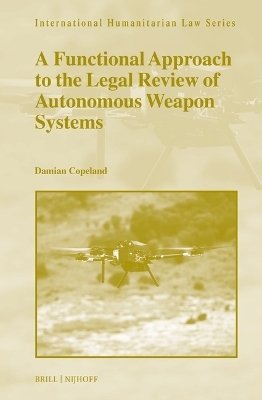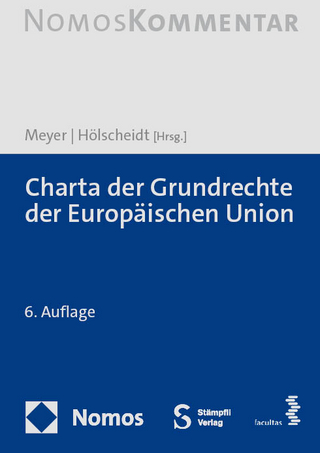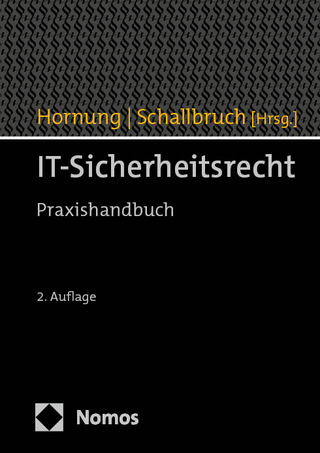
A Functional Approach to the Legal Review of Autonomous Weapon Systems
Martinus Nijhoff (Verlag)
978-90-04-70703-0 (ISBN)
Autonomous Weapon Systems (AWS) are no longer limited to science fiction. Conflicts in the Ukraine and Gaza demonstrate an increased trend toward the use of autonomy in the use of force in armed conflict. This book analyses the art 36 legal review obligation and assesses how states can determine the legality of AWS. It proposes a new ‘functional’ approach to legal review that considers both weapons law and targeting rules engaged by the autonomous functionality.
Damian Copeland, Ph.D. (2023), Australian National University, is the Director of Operations and International Law in the Australian Department of Defence. He is responsible for conducting Article 36 legal reviews for the Australian Defence Force.
Foreword
Acknowledgements
List of Tables
Table of Abbreviations
Glossary
Part 1
Is the Traditional Approach to Legal Reviews Sufficient to Determine the Legality of Autonomous Weapon Systems?
Introduction to Part 1
1 Introduction
1 Aim
2 Methodology and Scope
3 Why Is This Important?
4 Conclusions and Findings
2 A Survey of Academic Discourse on Legal Reviews
1 The icrc Period (1987–2006)
2 The laws Period (2012–2017)
3 The ccw gge Period (2018 to Present)
3 How Does International Law Regulate aws?
1 The Objectives of Weapons Law
2 Sources and Development of Weapons Law
2.1 Geneva Law and Hague Law
3 Specific and General Weapons Law
3.1 Specific Weapons Law Prohibitions
3.2 General Weapons Law Prohibitions
4 Martens Clause
4.1 Are Ethics Relevant to the Legal Review of aws?
4.2 Martens Clause as an Avenue for Considering Soft Law and National Governance Frameworks during a Legal review
5 Conclusions
4 Sources and Scope of the Legal Review Obligation and Application to aws
1 Origins of the Legal Review Obligation
1.1 Obligation of Good Faith
1.2 Treaty Law – Article 36 of ap 1
2 Analysing the Article 36 Operative Terms
2.1 ‘Study, Development, Acquisition or Adoption’
2.2 ‘[N]ew’ Weapon, Means or Method of Warfare
2.3 ‘Weapon, Means or Method of Warfare’
2.4 Meaning of ‘In Some or All Circumstances’
2.5 Meaning of ‘Prohibited by This Protocol or by Any Other Rule of International Law’
3 Conclusions Concerning the Art 36 Operative Terms
5 Identifying the Traditional Legal Review Process
1 Limited State Practice
2 Traditional Legal Review Process
2.1 Evidence of State Practice
2.2 icj – Nuclear Weapons Advisory Opinion
2.3 icrc Guide
2.4 Article 36 Legal Review and the National Defence Acquisition Process
3 Common Steps of the Traditional Legal Review Methodology Applied to aws
3.1 Preliminary Step – Determine Preliminary Questions
3.2 Step 1 – Analyse Specific Weapons Law Prohibitions and Restrictions
3.3 Step 2 – Apply General Prohibitions
3.4 Step 3 – Other Considerations, Including National Policy
4 Outcomes of the Traditional Legal Review Process
4.1 Use of the Weapon in Its Normal or Expected Use Is Lawful
4.2 The Use of the Weapon Is Lawful, but Limitations Are Required on Its Method of Use
4.3 The Weapon Is Unlawful in All Circumstances
4.4 Legal Review Outcomes Applied to aws
5 Traditional Legal Review Dichotomy between Weapons Law and Targeting Law
5.1 Applying Targeting Law in the Legal Review of an aws
6 Conclusions
Part 2
How Can a State Determine the Legality of an aws?
Introduction to Part 2
6 Interpretive and Methodological Questions in the Legal Review of aws
1 Article 36’s Interpretive Questions Arising from Autonomy in Weapons
1.1 Can the Legal Reviewer Presume an aws Will Be Used Lawfully?
1.2 Does the Legal Review of an aws Need to Identify Lines of Human Responsibility?
1.3 What Standards of ihl Compliance Are Required to Pass a Legal Review?
2 Methodological Questions
2.1 Should a Legal Review of aws Occur before and after the ‘Study, Development, Acquisition or Adoption’?
2.2 Should States Inform Industry of Their Legal Review Requirements?
2.3 Should a Legal Review Continue during an aws’ In-Service Life?
3 Conclusions Arising from the Interpretive and Methodological Questions
7 An Additional ‘Functional’ Legal Review Step to Address Autonomy in Weapons
1 Adding a Functional Review Step to the Traditional Legal Review Methodology
2 Describing the Elements of the ‘Functional Review’ Step
2.1 Functional Review (Element 1/8) – Identifying the ihl Rules Governing the aws’ Normal or Expected Use
2.2 Function Review (Element 2/8) – Identify the Standards of Legal Compliance Required to Determine Legality for that Function
2.3 Functional Review (Element 3/8) – Identify the Operational Context in Which the aws Will Perform the Function
2.4 Functional Review (Element 4/8) – Obtain aws Functional, Technical and Performance Information
2.5 Functional Review (Element 5/8) – Conduct a Legal Risk Analysis of Each aws Function Governed by ihl
2.6 Functional Review (Element 6/8) – Determine the Appropriate Level of Human Control
2.7 Functional Review (Element 7/8) – Identify Lines of Human Responsibility
2.8 Functional Review (Element 8/8) – Trust from Reliability, Predictability and Explainability
3 Conclusion
8 Proposal to Expand the Legal Review throughout the aws’ Lifecycle
1 Stage 1 – Informative Stage
1.1 Early Legal Review Self-assessment
2 Stage 2 – Determinative Stage
2.1 Test and Evaluation during the Determinative Stage
3 Stage 3 – Governance Stage
3.1 Relationship between Article 36 and Article 82 of ap 1
3.2 Environmental and Operational Certification
3.3 Functional Re-review
4 Conclusion
9 Conclusions and Findings
Bibliography
Index
| Erscheinungsdatum | 06.11.2024 |
|---|---|
| Reihe/Serie | International Humanitarian Law Series ; 72 |
| Sprache | englisch |
| Maße | 155 x 235 mm |
| Gewicht | 600 g |
| Themenwelt | Recht / Steuern ► EU / Internationales Recht |
| Recht / Steuern ► Öffentliches Recht ► Völkerrecht | |
| Recht / Steuern ► Strafrecht | |
| Sozialwissenschaften ► Politik / Verwaltung | |
| ISBN-10 | 90-04-70703-4 / 9004707034 |
| ISBN-13 | 978-90-04-70703-0 / 9789004707030 |
| Zustand | Neuware |
| Informationen gemäß Produktsicherheitsverordnung (GPSR) | |
| Haben Sie eine Frage zum Produkt? |
aus dem Bereich


